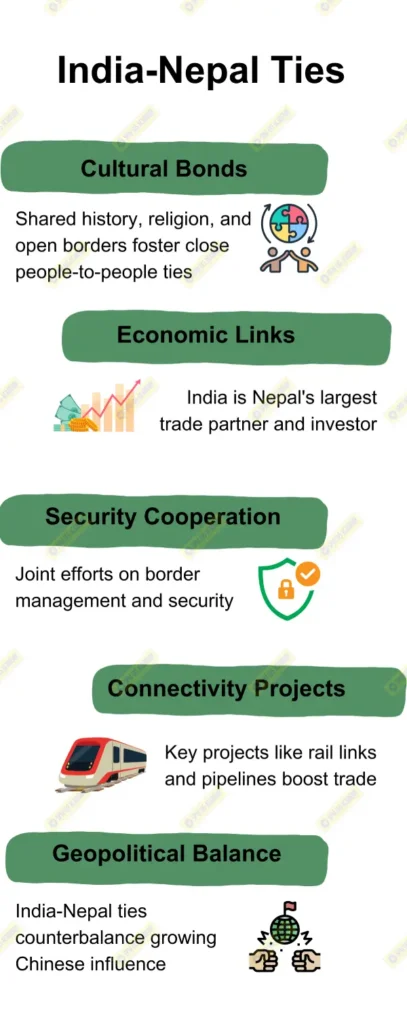India and Nepal share a relationship often described as “roti-beti ka rishta,” reflecting deep-rooted cultural, social, and familial ties. This relationship is characterized by an open border and people-to-people contacts that foster kinship and shared heritage. However, despite the historical warmth, the relationship has faced periods of tension, requiring a nuanced understanding of both cooperation and challenges.
Positive Aspects of India-Nepal Relations
- Historical and Cultural Affinity: India and Nepal share centuries-old religious, linguistic, and cultural connections. Hinduism and Buddhism are central to both societies, with significant pilgrimage sites such as Pashupatinath in Nepal and Varanasi in India attracting people across the border. As former Indian Prime Minister Atal Bihari Vajpayee once remarked, “India and Nepal are bound by a unique relationship, deeper than treaties, older than records.”
- Open Border and Economic Integration: The 1950 India-Nepal Treaty of Peace and Friendship allows citizens of both countries to cross borders without passports or visas, fostering trade, tourism, and economic interdependence. Remittances from the large Nepalese diaspora in India constitute a significant part of Nepal’s economy. According to data from the World Bank, remittances account for about 24% of Nepal’s GDP, with a substantial portion coming from India.
- Development Partnership: India has been a major development partner for Nepal, assisting in infrastructure projects like roads, railways, hydropower, and healthcare facilities. The Motihari-Amlekhgunj Petroleum Pipeline, inaugurated in 2019, is a notable example, ensuring efficient fuel supply to Nepal. Additionally, during the 2015 earthquake, India provided substantial humanitarian aid and reconstruction assistance.
Challenges and Tensions in the Relationship
- Border Disputes: Despite an open border, territorial disputes like Kalapani, Lipulekh, and Susta have caused friction. Nepal’s publication of a new political map in 2020, including contested territories, led to a diplomatic standoff. India maintains that the issue should be resolved through dialogue, in line with the principles of the 1950 Treaty.
- Perceptions of Big Brother Attitude: Nepal often perceives India as overbearing, especially in its political affairs. This perception was accentuated during the 2015 economic blockade, when many in Nepal believed India supported the Madhesi agitation against the new Nepalese Constitution. This blockade strained relations severely, leading to anti-India sentiments within Nepal.
- China’s Growing Influence: Nepal’s increasing engagement with China poses a strategic challenge for India. China’s investments in infrastructure and the Belt and Road Initiative (BRI) have deepened its ties with Nepal. In contrast, India emphasizes projects like the Sagarmatha Friendship Highway and rail links but faces competition in maintaining influence. As Henry Kissinger observed, “The balance of power is not just about power itself, but also about perception and influence.”
- Hydropower Diplomacy: While India and Nepal have cooperated on projects like the Mahakali Treaty and the Arun-III hydropower project, there have been disagreements over water sharing and project delays. Nepal often accuses India of failing to fulfill commitments, creating an environment of mistrust.
Contemporary Developments and Way Forward
- Recent Bilateral Initiatives: In 2023, India and Nepal have taken steps to reinvigorate ties through initiatives like the India-Nepal Joint Vision Statement on Power Sector Cooperation. This agreement aims to enhance cross-border energy trade, promoting Nepal as an energy exporter to India. Such efforts could transform Nepal into a regional energy hub in the long term.
- Strengthening Diplomatic Dialogue: Both countries have recently shown willingness to resolve disputes through high-level visits and diplomatic dialogue. The visit of Prime Minister Pushpa Kamal Dahal ‘Prachanda’ to India in 2023 signified an intent to reset ties. India has reiterated its commitment to “neighbourhood first,” focusing on mutual respect and partnership.
- People-to-People Engagements: Despite political differences, people-to-people ties remain robust. The cross-border festivals, cultural exchanges, and academic collaborations between universities sustain this soft power diplomacy. Additionally, India’s Gorkha Regiment, comprising Nepalese citizens, symbolizes the deep military and social links between the two nations.
Conclusion
The relationship between India and Nepal is indeed unique—rooted in shared culture and kinship, but it also faces challenges that require careful management. As Jawaharlal Nehru rightly said, “The Himalayan frontier is our vital frontier,” underscoring the importance of the Indo-Nepal relationship to India’s security and strategic interests. Going forward, fostering mutual trust, respecting sovereignty, and addressing bilateral concerns can ensure that this time-tested friendship adapts to contemporary challenges, creating a model of regional cooperation that benefits both nations.













